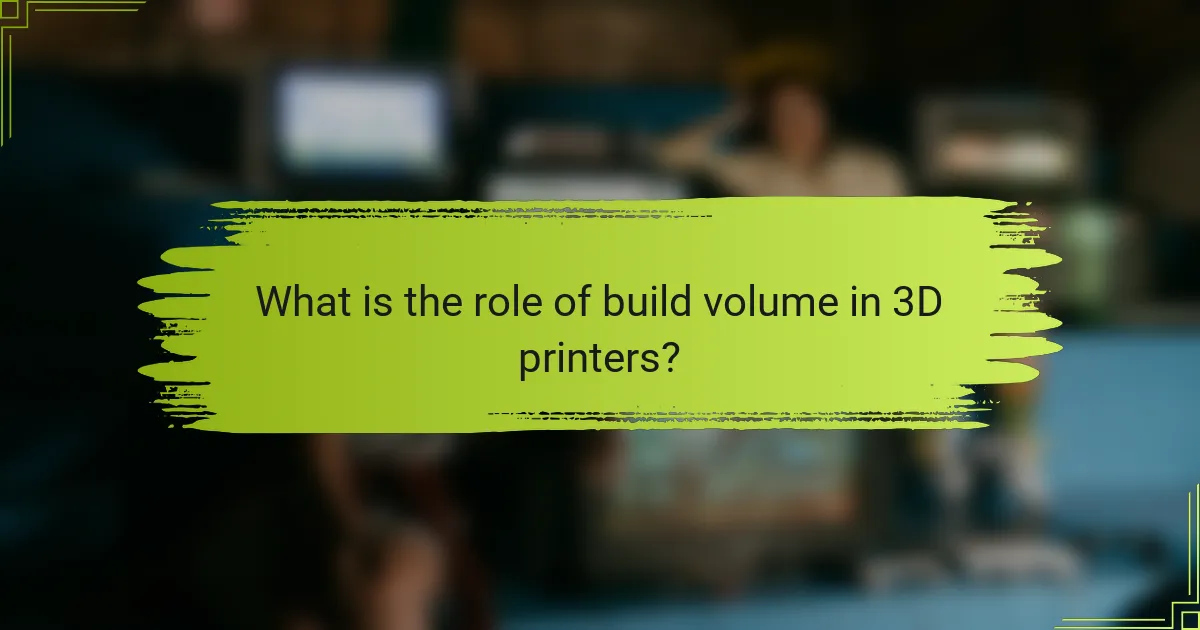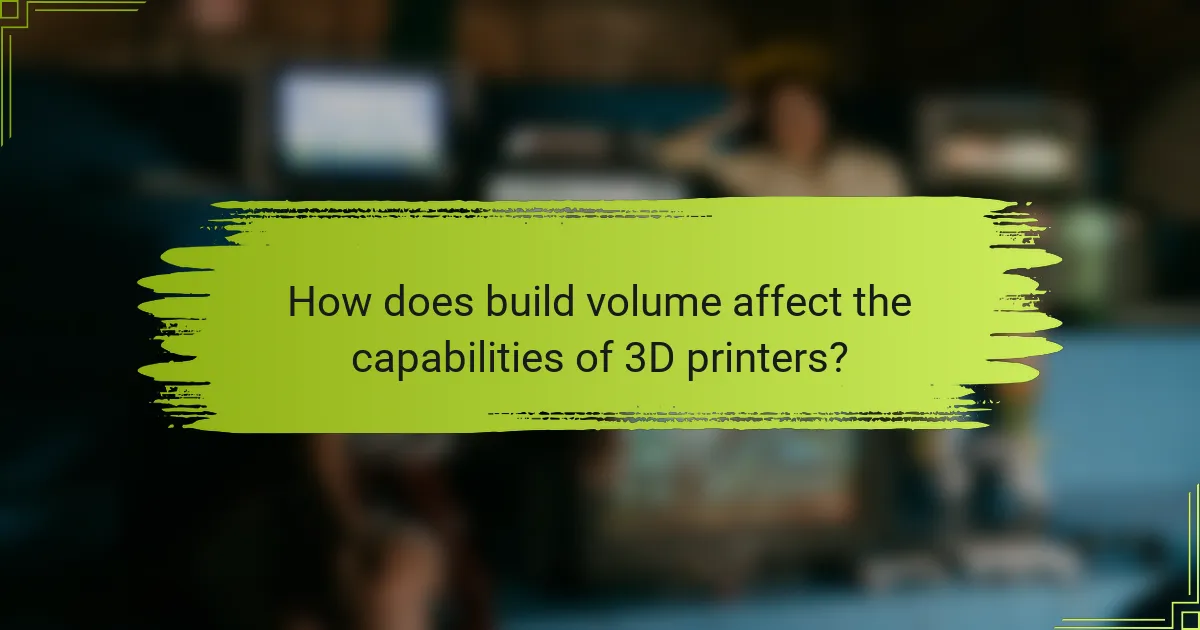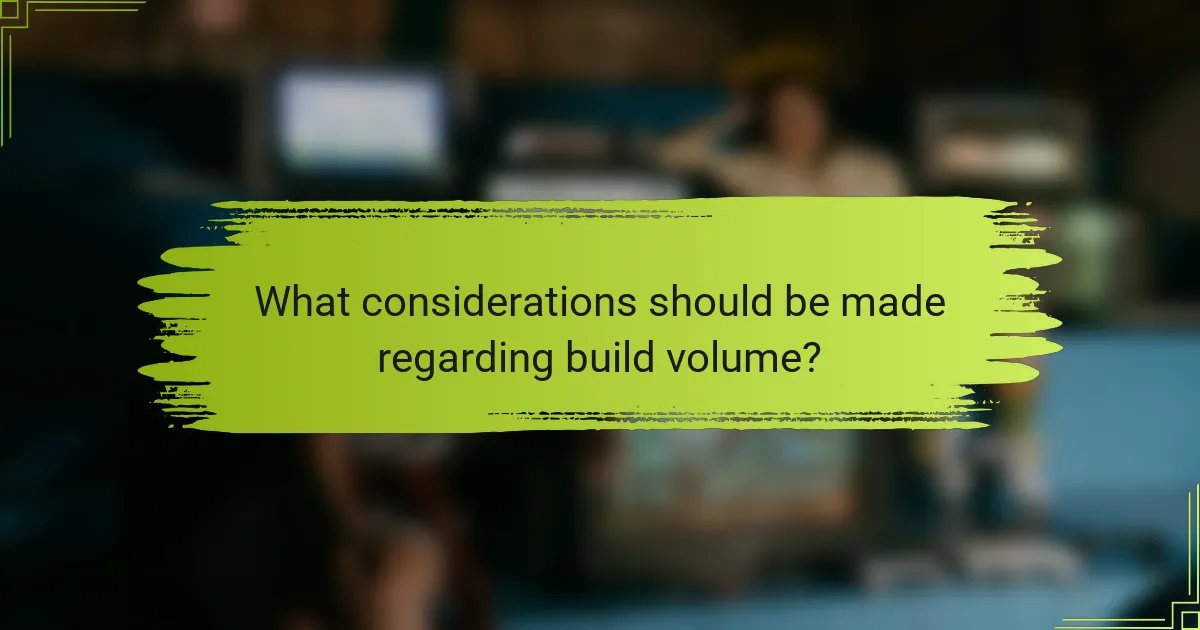
What is the role of build volume in 3D printers?
The build volume in 3D printers defines the maximum size of an object that can be printed. It is a crucial specification that determines the scale of projects a printer can handle. Larger build volumes allow for the creation of bigger and more complex models. This is particularly important in industrial applications where large prototypes or parts are needed. Conversely, home 3D printers typically have smaller build volumes, limiting the size of prints. The dimensions of the build volume are usually expressed in cubic centimeters or inches. For instance, a printer with a build volume of 300 x 300 x 400 mm can produce items up to that size. Understanding build volume helps users select the right printer for their specific needs.
How does build volume differ between industrial and home 3D printers?
Industrial 3D printers typically have a much larger build volume compared to home 3D printers. Industrial models often offer build volumes exceeding 1 cubic meter. This allows for the production of large parts or multiple items simultaneously. In contrast, home 3D printers usually have build volumes ranging from 100 to 300 cubic centimeters. The smaller size limits the complexity and scale of projects for home users. Industrial printers also accommodate various materials, enhancing their versatility. This difference in build volume reflects the intended use and capabilities of each type of printer.
What are the standard build volumes for industrial 3D printers?
Standard build volumes for industrial 3D printers typically range from 200 x 200 x 200 mm to 1000 x 1000 x 1000 mm. Some high-end models can exceed these dimensions, reaching volumes of up to 2000 x 2000 x 2000 mm. These dimensions allow for the production of larger parts and complex geometries. Industrial 3D printers are designed to meet the demands of various industries, including aerospace, automotive, and healthcare. The larger build volumes facilitate the creation of prototypes and end-use parts in a single print job. This capability enhances efficiency and reduces the need for assembly. Specific models, like the EOS P 800, offer a build volume of 700 x 380 x 580 mm, demonstrating the diversity in available sizes. Overall, the standard build volumes reflect the needs of industrial applications for larger and more intricate designs.
What are the standard build volumes for home 3D printers?
Standard build volumes for home 3D printers typically range from 120 x 120 x 120 mm to 300 x 300 x 400 mm. Most entry-level models have a build volume around 200 x 200 x 200 mm. Mid-range printers often feature volumes of 250 x 250 x 250 mm. High-end home 3D printers can reach volumes up to 400 x 400 x 400 mm. These dimensions allow users to create a variety of objects, from small prototypes to larger designs. The variation in build volume caters to different user needs and project requirements.
Why is build volume important in 3D printing?
Build volume is crucial in 3D printing because it determines the maximum size of objects that can be printed. A larger build volume allows for the creation of bigger, more complex designs in a single print. This is especially important for industrial applications where large prototypes or parts are often required. For home users, a suitable build volume enables the printing of functional items and creative projects without needing assembly. Insufficient build volume can limit design possibilities and require multiple prints, increasing time and material waste. Therefore, selecting a 3D printer with the appropriate build volume is essential for meeting specific project needs.
How does build volume impact design flexibility?
Build volume directly influences design flexibility by determining the maximum size of objects that can be printed. A larger build volume allows for more intricate and larger designs without the need for assembly. This capability enables designers to create complex geometries and features that would be impossible in smaller volumes. For instance, industrial 3D printers often have build volumes exceeding 1 meter, accommodating larger prototypes or functional parts. In contrast, home 3D printers typically have smaller build volumes, limiting the size and complexity of designs. Therefore, the build volume is a critical factor in the overall design process, affecting creativity and functionality in 3D printing.
What role does build volume play in production speed?
Build volume significantly impacts production speed in 3D printing. A larger build volume allows for the simultaneous production of multiple parts or larger components. This efficiency reduces the number of print cycles needed for the same quantity of output. Consequently, printers with larger build volumes can complete projects more quickly. For instance, industrial 3D printers often have larger build volumes compared to home models, enabling faster production rates. Studies indicate that larger build volumes can decrease overall production time by up to 30%. This efficiency is crucial in manufacturing settings where time-to-market is a critical factor.

How does build volume affect the capabilities of 3D printers?
Build volume directly impacts the capabilities of 3D printers by determining the maximum size of objects that can be printed. A larger build volume allows for the creation of bigger parts or multiple smaller parts in a single print job. This is essential for industries that require large prototypes or components, such as automotive or aerospace sectors. Conversely, smaller build volumes limit the size and complexity of the printed objects. For instance, home 3D printers typically have a build volume of around 200 x 200 x 200 mm, which restricts users to smaller projects.
In contrast, industrial 3D printers can have build volumes exceeding 1 meter in any dimension, enabling the production of large-scale designs. This capability enhances efficiency by reducing the need for assembly of multiple smaller parts. Additionally, larger build volumes can accommodate advanced materials and complex geometries that may not fit within smaller printers. Thus, the build volume is a critical factor that influences the versatility and application of 3D printing technology across different sectors.
What are the limitations of small build volumes in home 3D printers?
Small build volumes in home 3D printers limit the size of objects that can be printed. This restriction prevents the creation of larger prototypes or functional parts in a single print. Users may need to divide models into smaller sections, increasing time and complexity. It can also lead to issues with alignment during assembly. Additionally, small build volumes restrict experimentation with larger designs. This can hinder creativity and innovation in projects. Users may find it challenging to print certain intricate designs that require more space. Ultimately, these limitations can affect the overall usability and versatility of home 3D printers.
How does a limited build volume restrict project scope?
A limited build volume restricts project scope by limiting the size of objects that can be printed. This constraint can prevent the creation of larger, complex designs. It may force users to scale down projects or divide them into smaller parts. Smaller build volumes can limit the types of applications suitable for 3D printing. For example, industrial applications often require larger components that cannot fit within home printer limits. Additionally, the inability to print larger objects can impact functionality and design integrity. In practical terms, projects requiring extensive detail or multiple integrated parts may become unfeasible. This limitation can reduce innovation and creativity in design processes.
What challenges arise from printing large objects in smaller printers?
Printing large objects in smaller printers presents several challenges. The primary issue is limited build volume, restricting the size of objects that can be printed. This limitation often necessitates the division of large designs into smaller segments, complicating the assembly process. Additionally, the alignment of these segments can result in visible seams or misalignments, affecting the final object’s aesthetics and functionality.
Another challenge is increased print time. Printing large objects in multiple parts can significantly extend the overall production time. Material wastage can also occur if supports are needed for larger structures, leading to higher costs. Furthermore, smaller printers may struggle with maintaining consistent print quality across larger designs, as they are not optimized for such tasks.
Finally, the risk of printer malfunctions or failures increases with complex, large prints, as smaller printers may not be designed to handle the stress or thermal requirements of extensive builds. These challenges highlight the limitations of smaller printers in producing large-scale 3D printed objects effectively.
What advantages do larger build volumes offer in industrial 3D printers?
Larger build volumes in industrial 3D printers allow for the production of larger parts in a single print. This capability reduces the need for assembly, saving time and costs. It also enables the creation of complex geometries that may not fit in smaller printers. With a larger build volume, manufacturers can optimize material usage and minimize waste. Additionally, larger volumes facilitate batch production, increasing efficiency. For example, a printer with a build volume of 1000 x 1000 x 1000 mm can produce multiple components simultaneously. This scalability is crucial for industries requiring high-volume production. Overall, larger build volumes enhance operational flexibility and productivity in industrial 3D printing.
How does a larger build volume enhance production efficiency?
A larger build volume enhances production efficiency by allowing for the simultaneous production of multiple parts. This capability reduces the number of print jobs required for a project. It minimizes setup time and machine downtime. Consequently, fewer interruptions occur during the production process. Larger volumes also enable the printing of larger components in a single job. This leads to a reduction in material waste and post-processing time. Research indicates that larger build volumes can increase throughput by up to 30% in industrial settings. Overall, the efficiency gains from a larger build volume contribute to faster project completion and lower operational costs.
What types of projects benefit from larger build volumes?
Projects that benefit from larger build volumes include large-scale prototypes and architectural models. These projects require significant space to accurately represent dimensions. Larger build volumes facilitate the creation of complex geometries without needing assembly. They are also essential for manufacturing functional parts in industries like automotive and aerospace. Customization projects, such as furniture design, benefit from the ability to produce larger pieces in one print. Additionally, large artistic installations can be created more efficiently. The ability to print larger objects reduces time and material waste, enhancing overall productivity.

What considerations should be made regarding build volume?
Build volume refers to the maximum size of an object that a 3D printer can create. Considerations for build volume include the intended application of the printer. Larger build volumes are essential for industrial applications that require bigger parts. Smaller build volumes may suffice for home projects or prototypes. The printer’s design also impacts build volume; some printers have more compact frames. Material usage is another factor; larger prints consume more material. Additionally, print time increases with larger volumes, affecting production schedules. Lastly, the cost may rise with increased build volume due to more advanced technology needed.
How does the choice of build volume affect cost and investment?
The choice of build volume significantly affects cost and investment in 3D printers. Larger build volumes generally lead to higher costs due to increased material requirements and more complex manufacturing processes. Industrial 3D printers with substantial build volumes can range from $10,000 to over $100,000, while smaller home printers typically cost between $200 and $2,000.
Investing in larger build volumes allows for the production of larger parts or multiple items simultaneously, improving efficiency. However, this necessitates a higher upfront investment and ongoing operational costs, including maintenance and energy consumption. A study from Wohlers Associates indicates that companies with larger build volumes can achieve greater economies of scale, ultimately reducing per-part costs.
Choosing the appropriate build volume aligns with specific production needs, influencing both initial investment and long-term operational expenses.
What are the financial implications of larger build volumes?
Larger build volumes in 3D printing can lead to increased production costs. This is due to the higher material consumption for larger prints. Additionally, larger machines often require more energy, raising operational expenses. Maintenance costs may also be higher because of the complexity of larger printers. Economies of scale can be achieved, reducing per-unit costs when producing multiple items simultaneously. However, initial investment in larger equipment is significantly higher. This can impact cash flow and financial planning for businesses. Overall, the financial implications are a balance between increased costs and potential savings through efficiency and scale.
How can users optimize build volume for their specific needs?
Users can optimize build volume by selecting the right 3D printer that meets their specific requirements. They should assess the dimensions of the objects they intend to print. Understanding the maximum build size offered by different printers is essential. Users can also adjust the orientation of models to fit within the build area effectively. Utilizing slicing software allows for scaling and layout adjustments. Additionally, users can consider modular designs that can be printed in parts and assembled later. Research indicates that optimizing build volume can enhance printing efficiency and reduce material waste.
What best practices should users follow when selecting a 3D printer based on build volume?
Users should consider their project needs when selecting a 3D printer based on build volume. Determine the maximum size of the objects you intend to print. This ensures that the printer can accommodate your designs without scaling down. Evaluate the printer’s build volume specifications, usually listed in cubic centimeters or inches. A larger build volume allows for more complex or multiple prints simultaneously. Assess the available space for the printer in your workspace. Ensure that the printer’s dimensions fit comfortably in your designated area. Research the types of materials compatible with larger build volumes. Some materials may require specific printer capabilities to ensure quality. Finally, consider future projects that may require larger prints. This foresight can save you from needing to upgrade soon after purchase.
The main entity of this article is build volume in 3D printers, which defines the maximum size of objects that can be printed and is crucial for determining the capabilities of both industrial and home 3D printers. The article explores the differences in build volume between industrial and home printers, highlighting standard dimensions and their implications for project scope, design flexibility, and production efficiency. It also discusses the limitations of small build volumes in home printers, the advantages of larger volumes in industrial settings, and the financial considerations associated with choosing the appropriate build volume for specific needs. Overall, understanding build volume is essential for selecting the right 3D printer to meet various application requirements.